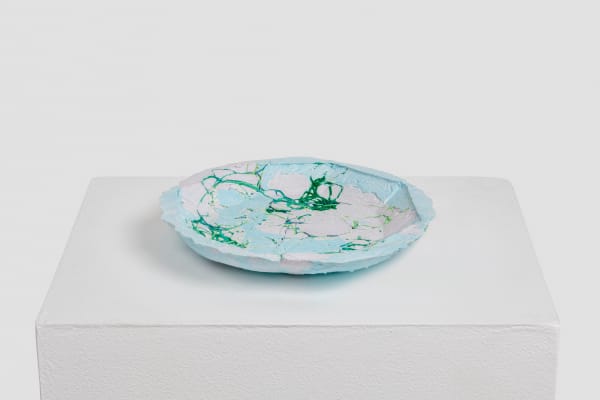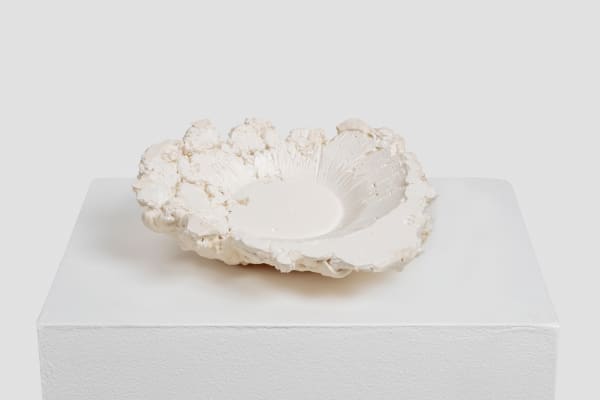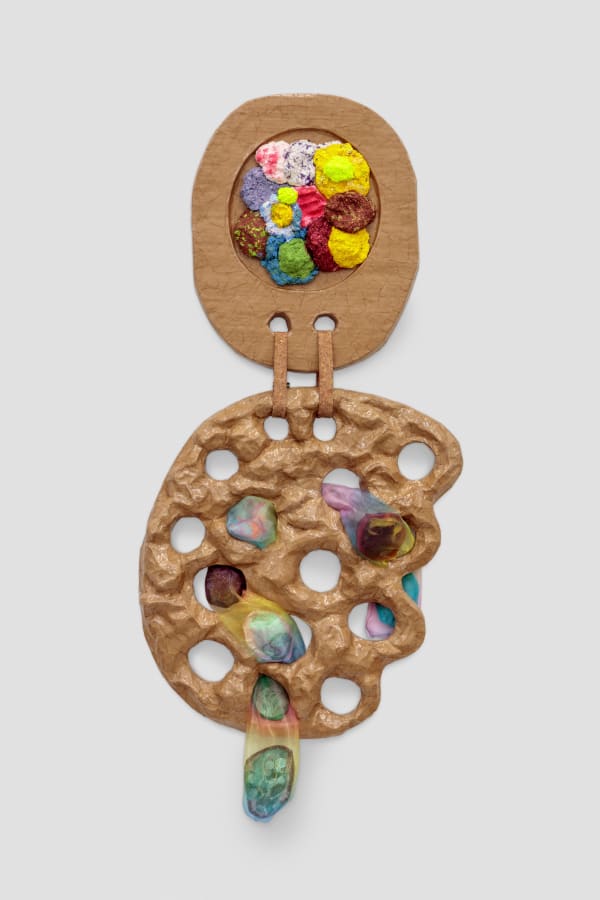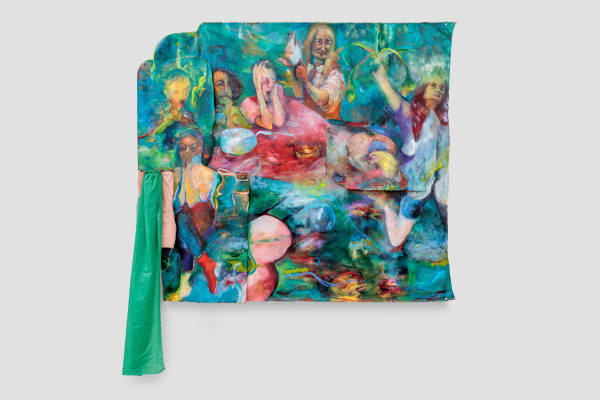Practicalities (La vita materiale): Curated by Marina Dacci
She is interested in a relational and processual unfolding of her projects, often on an extremely extended time scale.
-
 Alice CattaneoUntitled, 2019Murano glass, slate, ceramics, cotton thread
Alice CattaneoUntitled, 2019Murano glass, slate, ceramics, cotton thread -
 Elena El AsmarArioso Operoso, 2018Bleach and acrylic on cotton satin
Elena El AsmarArioso Operoso, 2018Bleach and acrylic on cotton satin -
 Elena El AsmarSpargo, lancio, divido, cospargo, 2014Oil on canvas
Elena El AsmarSpargo, lancio, divido, cospargo, 2014Oil on canvas -
 Elena El AsmarSpargo, lancio, divido, cospargo, 2014Oil on canvas
Elena El AsmarSpargo, lancio, divido, cospargo, 2014Oil on canvas -
 Elena El AsmarSpargo, lancio, divido, cospargo, 2014Oil on canvas
Elena El AsmarSpargo, lancio, divido, cospargo, 2014Oil on canvas -
 Serena FineschiCi è mancato il tempo, non l’amore (diptych), 2020Deconstructed furniture wood, enamel, rainwater
Serena FineschiCi è mancato il tempo, non l’amore (diptych), 2020Deconstructed furniture wood, enamel, rainwater -
 Serena FineschiIngannare l'attesa (Rothko n. 17), 2020Green and blue Bic Cristal pen on paper
Serena FineschiIngannare l'attesa (Rothko n. 17), 2020Green and blue Bic Cristal pen on paper -
 Ludovica GiosciaBeetroot Symphony, 2022Plaster, India ink, tissue paper, varnish
Ludovica GiosciaBeetroot Symphony, 2022Plaster, India ink, tissue paper, varnish -
 Ludovica GiosciaCosmic Pathways, 2022Plaster, paper pulp, wool, varnish
Ludovica GiosciaCosmic Pathways, 2022Plaster, paper pulp, wool, varnish -
 Ludovica GiosciaDeep space, 2022Plaster, varnish
Ludovica GiosciaDeep space, 2022Plaster, varnish -
 Ludovica GiosciaOpus Carmenticium, 2022Plaster, paper, screen printed wallpaper pulp, varnish
Ludovica GiosciaOpus Carmenticium, 2022Plaster, paper, screen printed wallpaper pulp, varnish -
 Ludovica GiosciaVaniglia, Cocco e Cioccolato, 2022Plaster, pigments, cosmetic packaging paper pulp, varnish
Ludovica GiosciaVaniglia, Cocco e Cioccolato, 2022Plaster, pigments, cosmetic packaging paper pulp, varnish -
 Ludovica GiosciaEager Follicole, 2022Cardboard, papier-mâché, wood, ova and fabric
Ludovica GiosciaEager Follicole, 2022Cardboard, papier-mâché, wood, ova and fabric -
 Loredana LongoCarpet #39, 2020Burn on Oriental carpet
Loredana LongoCarpet #39, 2020Burn on Oriental carpet -
 Loredana LongoCreative Execution #4 Warning/2, 2019Exploded raw clay pots
Loredana LongoCreative Execution #4 Warning/2, 2019Exploded raw clay pots -
 Claudia LosiAsking Shelter X, 2018Bronze, brass, silver
Claudia LosiAsking Shelter X, 2018Bronze, brass, silver -
 Claudia LosiLingua foglia, 2020Laser-cut wrought iron
Claudia LosiLingua foglia, 2020Laser-cut wrought iron -
 Claudia LosiLingua foglia, 2020Laser-cut wrought iron
Claudia LosiLingua foglia, 2020Laser-cut wrought iron -
 Claudia LosiLingua foglia, 2020Laser-cut wrought iron
Claudia LosiLingua foglia, 2020Laser-cut wrought iron -
 Claudia LosiWords, 202221 5/8 x 21 5/8 x 3 1/8 in
Claudia LosiWords, 202221 5/8 x 21 5/8 x 3 1/8 in
55 x 55 x 8 cm -
 Claudia LosiWorlds, 2022Beads, horsehair, human hair, cotton fabric
Claudia LosiWorlds, 2022Beads, horsehair, human hair, cotton fabric -
 Claudia Losi and Sabrina Mezzaquidi mano in mano, di passo in passo, 2017Beads, lead, paper, cotton fabric, thread
Claudia Losi and Sabrina Mezzaquidi mano in mano, di passo in passo, 2017Beads, lead, paper, cotton fabric, thread -
 Sabrina MezzaquiFiori minuti, 2022Ceramic, paper, metal
Sabrina MezzaquiFiori minuti, 2022Ceramic, paper, metal -
 Sabrina MezzaquiChe tu sia per me il coltello, 2014Carved book (David Grossman, "Be my knife"), paper scraps, glue, thread
Sabrina MezzaquiChe tu sia per me il coltello, 2014Carved book (David Grossman, "Be my knife"), paper scraps, glue, thread -
 Sophie WahlquistKrake, 2022Ceramic, glaze, bulbs, wire and metal chain
Sophie WahlquistKrake, 2022Ceramic, glaze, bulbs, wire and metal chain -
 Sophie WahlquistSearch, find, select, grasp, position, assemble , release, wait, 2022Oil on canvas, fabric
Sophie WahlquistSearch, find, select, grasp, position, assemble , release, wait, 2022Oil on canvas, fabric


































